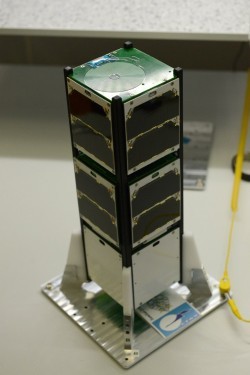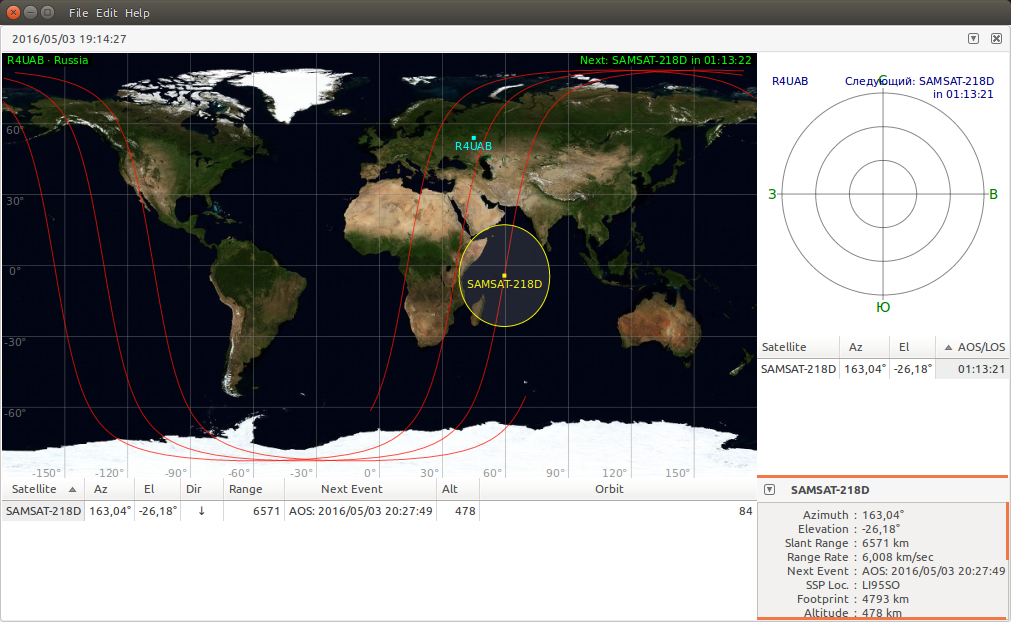The Russian satellite SamSat-218 does not communicate. Need help from the community
Developers turned to radio amateurs for help in searching for satellite signals
 On April 28, the Soyuz-2.1a launch vehicle launched three spacecraft into orbit: the Lomonosov, Aist-2D and SamSat-218 (SamSat-218).
On April 28, the Soyuz-2.1a launch vehicle launched three spacecraft into orbit: the Lomonosov, Aist-2D and SamSat-218 (SamSat-218).The Lomonosov spacecraft with a mass of 645 kg is equipped with a space telescope to measure the energy spectrum and chemical composition of extremely high-energy cosmic rays, and the instrument sets for research of cosmic gamma-ray bursts and the Earth’s near magnetosphere are installed on board the apparatus.
Aist-2D is a Russian remote sensing satellite with a resolution of up to 1.5 m.
')
The satellite “SamSat-218” is a project of students of the Samara State Aerospace University (SSAU) and designers of the Progress RCC, which is part of the “Kontakt” complex of scientific equipment. The second part of the complex is located on board the small Aist-2D spacecraft. The task of the complex is to work out the control technology of small spacecraft.
The launch from the Vostochny cosmodrome was successful .
April 28, 2016 at 08:13 Moscow time the devices first appeared in the radio visibility zone. The first signals from the satellites Aist-2D and Lomonosov were immediately discovered, radio amateur Dmitry Pashkov said in his blog .
But the satellite "SamSat-218" was silent.
It has been six days since launch, but no signals have yet been received from the satellite.
Radio-frequency bands 145.85-145.89 MHz (space-to-Earth) and 435.59-435.61 MHz (Earth-to-space) are allocated for communication with SamSat-218. Unfortunately, there is still no presence of the SamSat-218 satellite at these frequencies.

“It cannot be ruled out that the device simply did not turn on for some reason after separation, the on-board computer did not work, batteries and other possible causes are not charged,” writes Dmitry Pashkov.
Yesterday, the team of developers of the nanosatellite of the interuniversity space research department of the SSAU turned for help to all radio amateurs who have the ability to receive signals from satellites in the VHF band (144 MHz).
The satellite has a radio beacon that transmits every 150 seconds (or 30 seconds) the word SamSat-218D for 15 seconds at a frequency of 145.870 MHz. Transmission is carried out by Morse code in CW mode. During the passage of the satellite over our receiving station, we hear fragmentary Morse code on the background of noise, but we are not sure of the degree of its reliability. We are asking to listen to the air on the above frequency, record the audio signal and send it to teomant@bk.ru . For all questions related to the reception, we are ready to provide additional information, if necessary. Processing a large amount of data will allow us to understand the nature of the problem (perhaps the satellite is strongly twisted when leaving the transport and launch container) and try to estimate the rotation speed.SAMSAT-218D
1 41466U 16026C 16125.25494875 .00012535 00000-0 44298-3 0 9991
2 41466 97.2755 31.2653 0009906 239.0998 279.3893 15.29281052 929
You can try receiving signals from the SamSat-218 satellite at the online WEBSDR receiver , tuning in at a frequency of 145.870 MHz.
Source: https://habr.com/ru/post/393823/
All Articles